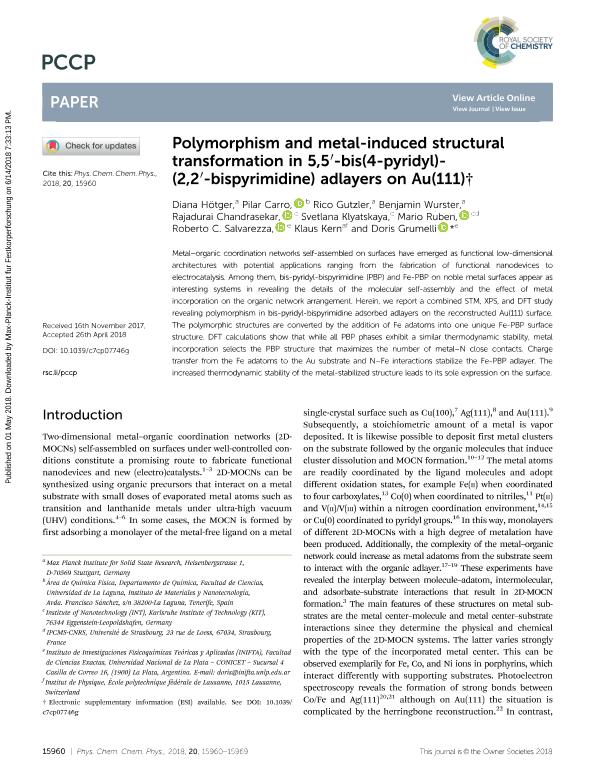Artículo
Polymorphism and metal-induced structural transformation in 5,5′-bis(4-pyridyl)(2,2′-bispyrimidine) adlayers on Au(111)
Hötger, Diana; Carro, Pilar; Gutzler, Rico; Wurster, Benjamin; Chandrasekar, Rajadurai; Klyatskaya, Svetlana; Ruben, Mario; Salvarezza, Roberto Carlos ; Kern, Klaus; Grumelli, Doris Elda
; Kern, Klaus; Grumelli, Doris Elda
 ; Kern, Klaus; Grumelli, Doris Elda
; Kern, Klaus; Grumelli, Doris Elda
Fecha de publicación:
05/2018
Editorial:
Royal Society of Chemistry
Revista:
Physical Chemistry Chemical Physics
ISSN:
1463-9076
Idioma:
Inglés
Tipo de recurso:
Artículo publicado
Clasificación temática:
Resumen
Metal-organic coordination networks self-assembled on surfaces have emerged as functional low-dimensional architectures with potential applications ranging from the fabrication of functional nanodevices to electrocatalysis. Among them, bis-pyridyl-bispyrimidine (PBP) and Fe-PBP on noble metal surfaces appear as interesting systems to reveal details of molecular self-assembly and the effect of metal incorporation on the organic network arrangement. Here, we report a combined STM, XPS, and DFT study revealing polymorphism for bis-pyridyl-bispyrimidine adsorbed adlayers on the reconstructed Au(111) surface. The polymorphic structures are converted by the addition of Fe adatoms into one unique Fe-PBP surface structure. DFT calculations show that while all PBP phases exhibit similar thermodynamic stability, metal incorporation selects the PBP structure which maximizes the number of Fe-N close contacts. Charge transfer from the Fe adatom to the Au substrate and N-Fe interactions stabilize the Fe-PBP adlayer. The increased thermodynamic stability of the metal-stabilized structure leads to its sole expression on the surface.
Palabras clave:
SELF ASSEMLED
,
2D METAL ORGANIC NETWORKS
,
STM DFT
,
XPS
Archivos asociados
Licencia
Identificadores
Colecciones
Articulos(INIFTA)
Articulos de INST.DE INV.FISICOQUIMICAS TEORICAS Y APLIC.
Articulos de INST.DE INV.FISICOQUIMICAS TEORICAS Y APLIC.
Citación
Hötger, Diana; Carro, Pilar; Gutzler, Rico; Wurster, Benjamin; Chandrasekar, Rajadurai; et al.; Polymorphism and metal-induced structural transformation in 5,5′-bis(4-pyridyl)(2,2′-bispyrimidine) adlayers on Au(111); Royal Society of Chemistry; Physical Chemistry Chemical Physics; 20; 23; 5-2018; 15960-15969
Compartir
Altmétricas



